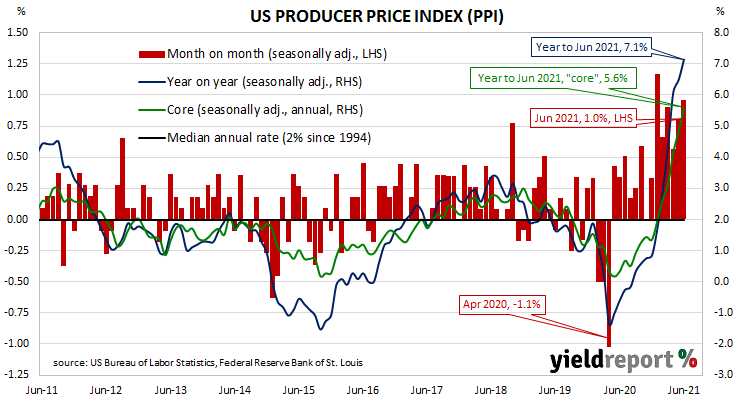Summary: Prices received by producers rise by 1.0% in June; double expected figure; annual rate moves above 7%; “core” PPI also increases by 1.0%; “current raft of price rises is transitory repeatedly made clear” by Fed; services prices up 0.8%, goods up 1.2%.
Around the end of 2018, the annual inflation rate of the US producer price index (PPI) began a downtrend which continued through 2019. Months in which producer prices increased suggested the trend may have been coming to an end, only for it to continue, culminating in a plunge in April 2020. Figures returned to “normal” towards the end of that year and annual rates are now well above average.
The latest figures published by the Bureau of Labor Statistics indicate producer prices rose by 1.0% after seasonal adjustments in June. The increase was double the 0.5% rise that had been generally expected and more than May’s 0.8% rise. On a 12-month basis, the rate of producer price inflation after seasonal adjustments increased from 6.5% to 7.1%.

PPI inflation excluding foods and energy, or “core” PPI inflation, also rose by 1.0%, up from the 0.7% increases which occurred in April and May. The annual rate accelerated again, this time from 4.8% to 5.6%.
Despite the larger than expected increases, US Treasury bond yields fell noticeably on the day following “dovish” testimony from Fed chief Jerome Powell to a Congressional committee. By the end of the day, the 2-year Treasury yield had lost 4bps to 0.22% while 10-year and 30-year yields each finished 8bps lower at 1.34% and 1.97% respectively.
ANZ economist John Bromhead noted the Fed “has repeatedly made it clear that it thinks the current raft of price rises is transitory, resulting from temporary supply-chain issues and the reopening of the economy. For now, this is limiting the market impact of these strong data prints.”
The BLS stated higher prices for final demand services accounted for 60% of the month’s increase after they rose by 0.8% on average. Prices of final demand goods rose by 1.2%.
The producer price index (PPI) is a measure of prices received by producers for domestically produced goods, services and construction. It is put together in a fashion similar to the consumer price index (CPI) except it measures prices received from the producer’s perspective rather than from the perspective of a retailer or a consumer. It is another one of the various measures of inflation tracked by the US Fed, along with core personal consumption expenditure (PCE) price data.

